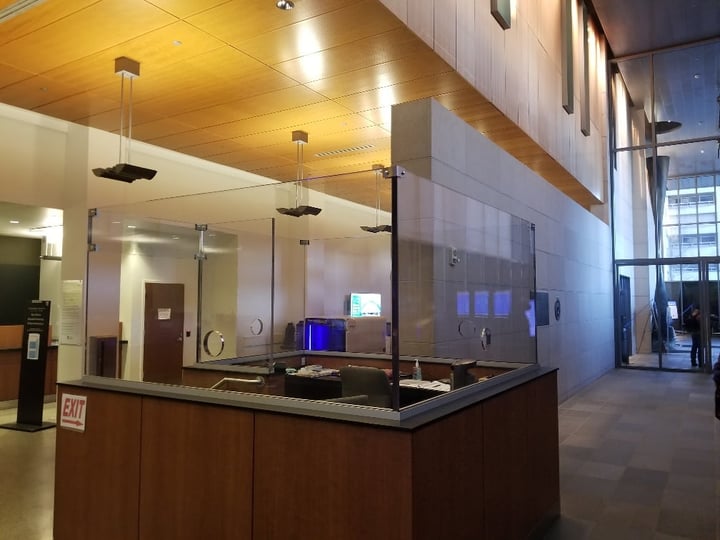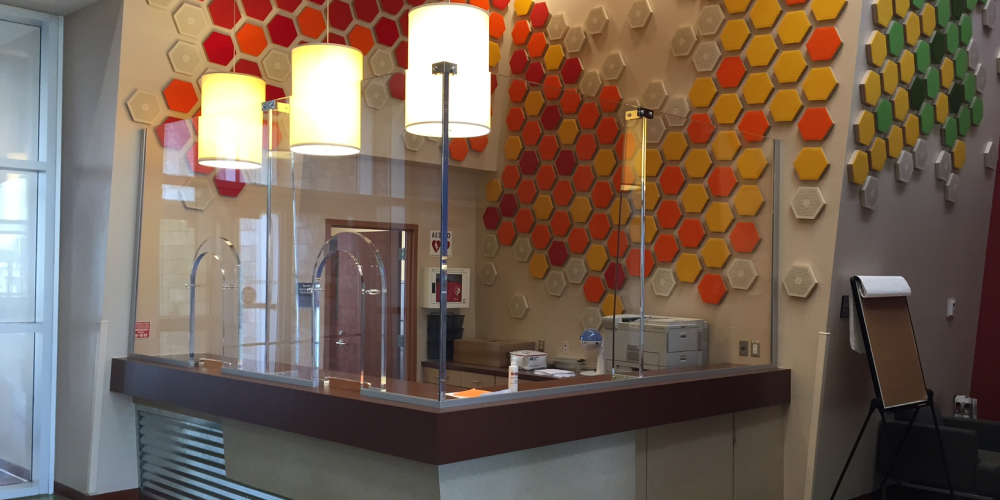According to The Violence Project, mass public shootings most frequently occur in workplaces. More than thirty percent of the mass shootings recorded since the mid-1960s were at places of business. The damage is not limited to fatalities: In 2020 alone, 20,050 workers experienced trauma as a result of workplace violence.
Reception staff are any office’s first line of defense. On most days, that’s a metaphor: They intercept distractions, calm angry customers, receive packages and food deliveries, field calls, and direct confused visitors. But in the event of a crisis, these staff are literally protecting the rest of the building’s occupants from disaster.
The primary goal of reception-area security measures is always to make receptionists’ workspace safer and less stressful—not just on the worst possible day, but every day. Let’s examine how to design functional and secure reception areas, checkpoints, and vestibules.
Design Functional Reception Spaces With Ballistic Glass, Doors, and Fiberglass
Overall, the most important element of reception-area security is to make sure it increases staff safety and security without getting in the way. This is the biggest issue Total Security Solutions CEO Jim Richards sees with poorly designed or implemented bulletproof barrier systems in office settings.
“What I see most often,” Jim says, “is a system that was clearly designed and installed by someone who didn’t take the time to understand how the people do business and work. So, you end up with a reception-area security barrier that people can’t hear each other through or where the receptionist has to come out to sign for a package. Or, you have a glazer or contractor who doesn’t understand what the ballistic products are capable of doing in that environment.”
Standard reception-area security barriers are composed of three key elements: A glass barrier in front of the desk or counter, bullet-resistant fiberglass reinforcing the walls and reception desk, and a ballistic door controlling access to the offices beyond the waiting area.
1. Ballistic Glass
Ballistic glass barriers in office reception areas are usually Level 1 or 3 ballistic acrylic or LP 1250. (Learn more about the difference between acrylic and polycarbonate bullet-resistant windows here.) For reception-area security, TSS tends to use minimalist framing, to keep the system as optically clear as possible.
TSS usually recommends an operable sliding window, which facilitates both easy communication and high functionality. It also has the benefit of familiarity: “Many reception areas already have a window for privacy,” Jim notes. “It’s usually thin polycarbonate or quarter-inch tempered glass, with a horizontal slider they can open at one of the stations. It’s something people are used to seeing and working with. If possible, we like to duplicate that, but bullet resistant.”
2. Ballistic Doors
Ballistic doors from TSS are always custom-made to best blend with the existing fixtures and aesthetic. For most reception areas, a fiberglass-reinforced wood door will both look good and be easy for contractors or locksmiths to work with if you ultimately want to upgrade the locks or install an access control system or “buzz-thru” electric strike system.
3. Bullet-Resistant Fiberglass
TSS always advises ballistic fiberglass reinforcement for walls and the reception desk. Unfortunately, Jim notes, this is an area where people often cut costs. Bear in mind that drywall and plywood will not stop even small-caliber bullets. If you are working with a contractor or security integrator, it’s worth asking if the reception desk, kick spaces, and vulnerable walls will be reinforced with ballistic fiberglass.
Use Bulletproof Checkpoints and Vestibules for High Traffic Lobbies
Offices with greater security needs might choose a bulletproof security booth or vestibule for lobby security.
A ballistic security booth/check-in station in the lobby is especially popular in high-traffic buildings, like municipal and government offices. This allows security officers to safely vet visitors before they get close to office staff or sensitive areas. Check-in stations can be a standalone kiosk (as shown below), or part of a more extensive security barrier like the work TSS did to help improve lobby security in the Conrad B. Duberstein U.S. Bankruptcy Courthouse.

Another popular approach to tighten lobby security is installing a secure vestibule. Here, TSS ballistically secures an existing entryway or doorway by replacing (or installing) bullet-resistant interior vestibule doors controlled by an electric “buzz-thru” system, and adding a transaction window to the vestibule wall. Visitors must check in at the transaction window before staff buzzes them into the building itself. TSS first developed this “bulletproof vestibule” solution more than ten years ago as a cost-effective security upgrade for schools. Many non-educational facilities have since adopted this system.
“Over the last five years or so, secure vestibules have become a fairly standard feature in many offices,” Jim explains. “When we started with these vestibule retrofits around 2013, it was a very school-specific solution, in response to how attacks had changed. Unfortunately, that kind of attack has only become more prevalent and spread further. So we’ve seen increasing interest in lobby security in general, and the secure vestibule particularly.”
Avoid Common Lobby Security Barrier Mistakes
Jim sees many unattractive or dysfunctional reception area security barriers. In general, this is the result of either the designer or installer having little experience working with ballistic materials or not taking the time to understand how the business operates.
For example, Jim often sees reception areas where visitors struggle to be heard or accomplish basic tasks.
“As I mentioned before, voice communication is the big one. If the person putting in this barrier doesn’t know how to do actual voice communication, they tend to make choices that don’t work for a reception area. So, if they do a hole-and-backer—which we don’t advise in that setting—it’s too small, or they use the metal-cover style. Both of those choices are really hard to hear through. We also see a lot of the wrong kind of cash tray. They put in a standard cash tray, but most offices aren’t passing cash. It’s paperwork on a clipboard, or big envelopes and folders, or even something like blueprints. There are many different solutions for any of these, but a cash tray isn’t one of them. If you want to keep it secure, and you’re installing a fixed system with no slider, you’ve got to have the right cash tray or passer.”
Jim also finds that less experienced contractors and glazers use too much framing.
“I see this quite a lot,” Jim says. “A lot of glazers working with these unfamiliar ballistic materials want to put frames and framing everywhere. Instead of putting big pieces of glass in, they’ll split everything up with verticals, and it ends up looking chopped up. It can feel like you’re in a cage.”
TSS designs and fabricates aesthetically pleasing, unobtrusive, highly functional security barriers. Our proven process ensures that’s what businesses get, every time.
Improve Your Lobby Security with TSS
Financial, corporate, healthcare, utility, and municipal offices all have different missions and clientele, but their lobbies have similar security needs. Curious about the next steps to secure your lobby or reception area? Contact our ballistic security experts if you have questions or want to get started with a specific project.

